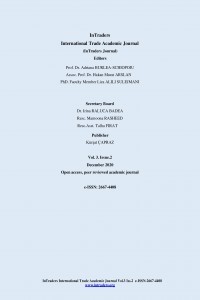Traders As (Inter) Cultural Agents: Turkish-Romanian Relations
Traders As (Inter) Cultural Agents: Turkish-Romanian Relations
The study aims to explore the complex relationship between trade/traders and culture. Since ancient times, traveling traders have helped the increment of intercultural dialogue, so, their work could be seen as an “osmotic” process. They have not only circulated goods but also ideas, concepts (from the field of science, religion, or philosophy), and vocabulary (they brought words from one nation or ethnic group to another, blending languages). One can assert that international trade is not a mere exchange of products but an occasion for mutual cultural enrichment. The main research question of the current paper is: “How can international traders sustain the intercultural dialogue?”, from this point the analysis will research the complexity of relations established by merchants among different cultures across numerous periods of time. In the study, we will mainly focus on the commercial relationship between Turkey and Romania. The used methodology includes historicism, cultural studies, interculturality, imagology, along with a literature review and analysis of the intercultural trading interaction between Turkey and Romania.
Keywords:
Culture, Intercultural Dialogue International Trade, Turkey, Romania,
___
- Adana Sanayi Odası (2020). Romanya Ülke Bilgi Notu. Erişim tarihi: 18.09.202,1 http://www.adaso.org.tr/WebDosyalar/Yayinlar/%C3%9Clke%20Raporlar%C4%B1-Y%C3%B6netici%20%C3%96zetleri/200108_Romanya%20%C3%9Clke%20Raporu.pdf.
- Arslan, Ü. (2014). Uluslararası ticaret ve kültürel yakınlık: Asya örneği, Marmara Üniversitesi İ.İ.B. Dergisi, 36(1), 89-101.
- Bedir, Ö. (2020). From voivodeships to modern romania with regard to ıts relations with the Ottoman Empire: Ottoman-Romanian diplomatic relations. Artuklu Human and Social Science Journal, 5(2), 56-72.
- Beller, M. (2007). Perception, ımage, ımagology. In C. Cedric, M. Beller and J. Leerssen (Eds), Imagology: The cultural construction and literary representation of national characters. Amsterdam & New York: Rodopi.
- Curtin, P. D. (1984). Cross-cultural Trade in World History. Cambridge: Cambridge University Press.
- Cyrus, T. L. (2012). Cultural distance and bilateral trade. Global Economy Journal, 12(4), 1-23.
- Çelik, O. (2018). “Romanya Ülke Raporu”, İzmir Ticaret Odası, Uluslararası İlişkiler Müdürlüğü. Erişim tarihi: 12.09.2021, https://api.izto.org.tr/storage/Documents/original/F8AY0Tg60lUElVIP.pdf
- Hofstede, G. (2011). Dimensionalizing cultures: the hofstede model in context, Online Readings in Psychology and Culture, 2 (1).
- Hofstede, G. (1983). National cultures in four dimensions, International Studies of Management and Organization, 13(1-2), 46-74.
- Hofstede, G. (1980). Culture's Consequences: International Differences in Work - Related Values, Abridged Edition, Sage Publications, USA.
- İnşaat elemanı.com (2021). Romanya’da iş yapan Romanya’ya işçi götüren firmalar. Erişim tarihi: 22.09.2021, https://insaatelemani.com/romanyada-is-yapan-romanyaya-isci-goturen-turk-firmalar.
- Karadeniz Ereğli Ticaret Odası (2020). Romanya Ülke Raporu-2020. Erişim tarihi: 12.09.2021, https://www.ereglitso.org.tr/dosya/2020-romanya-ulke-raporu_7937.pdf
- Kuşku Sönmez, E. (2018). Türkiye’nin Orta ve Doğu Avrupa’daki kararsız müttefikleri: Türkiye’nin Avrupa Birliği sürecine yönelik desteğin dinamikleri, Ankara Avrupa Çalışmaları Dergisi, 17(1), 153-179.
- Liu, A.; Lu, C. and Wang, Z. (2020). The roles of cultural and institutional distance in international trade: evidence from China's trade with the Belt and Road countries, China Economic Review, 61, 1-17.
- Lynch, D. A. (2010). Trade and Globalization: An Introduction to Regional Trade Agreements. Plymouth: Rowman & Littlefield.
- Metin, Ö. (2012). Atatürk Dönemi Türk Dış Ticaretinde Romanya’nın Yeri. The History School, Fall-Winter, 13, 53-68.
- Mornah, D. and MacDermott, R. (2011). Culture as a determinant of competitive advantage in trade, International Journal of Business and Economic Sciences Applied Research, 9(1), 69-76.
- Ömer, M. (2011). Atatürk Dönemi Türkiye-Romanya İlişkileri (1923-1938), (Unpublished PhD Thesis), Gazi Üniversitesi Sosyal Bilimler Enstitüsü Tarih Anabilim Dalı, Ankara.
- Ömer, M. (2019). Migration perspective in Romania-Turkey relations (1923-1936), CTAD, 15(30), 309-332.
- Tadesse, B. and White, R. (2019). Immigrants, Cultural Differences, and Trade Costs, International Migration, 55 (1), 51-74.
- Tarihte Türk-Rumen İlişkileri (2006), Genelkurmay ATASE ve Denetleme Başkanlığı Yayınları, Genelkurmay Basımevi, Ankara.
- T.R. Ministry of Foreign Affairs (2021). Relations between Turkey and Romania. Erişim tarihi: 21.09.2021, https://www.mfa.gov.tr/relations-between-turkey-and-romania.en.mfa
- TUIK (2021). Türkiye-Romanya ikili ticareti (ithalat-ihracat), 4 Ekim 2021, e-mail, https://mail.google.com/mail/u/0/#search/t%C3%BCik/QgrcJHsHqfsVLBjnwZqGzJXVlSBnCQWfRtL
- Türk Dil Kurumu (2021). Güncel Türkçe Sözlük. Erişim tarihi: 16.10.2021, https://sozluk.gov.tr/.
- Ural, S. and Kılınç, S. (2015). The Relations Between Turkey and Romania (1923-1950). The Journal of KAU IIBF, 6(11), 177-202.
- Wick, P. and Volker, V. (2014). Religions and Trade: Religious Formation, Transformation and Cross-Cultural Exchange between East and West, Leiden & Boston: Brill.
- Wang, Y., Yang, Z. and Yasar, M. (2020). A Multilevel investigation into the effect of cultural distance on bilateral trade: The roles of product type and uncertainty avoidance, Canadian Journal of Administrative Sciences, 37(1), 495-512.
- Yayın Aralığı: Yılda 2 Sayı
- Başlangıç: 2018
- Yayıncı: Kürşat ÇAPRAZ
Sayıdaki Diğer Makaleler
ABD İran İlişkileri: İran’ın Rolü ve Ekonomik Yaptırımlar Üzerine Bir Değerlendirme
Mert Eymen KAYALP, Dilşad TÜRKMENOĞLU KÖSE
Economic Causes Of Theft In 25 OECD Countries: Dynamic Panel Data Analysis
Traders As (Inter) Cultural Agents: Turkish-Romanian Relations
Asena BOZTAŞ, Marinică Tiberiu ȘCHİOPU, Selma KILIÇ KIRILMAZ
Türk- Alman Sosyoekonomik İlişkilerinde Ulus-Ötesi Göçmenlerin Önemi
